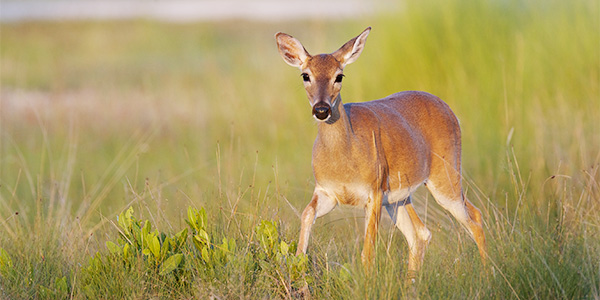

Please wait..


Please wait..

30 Dec 2024 Blogs
Nestled within the subtropical paradise of the Florida Keys, the Key deer (Odocoileus virginianus clavium) is a remarkable species of white-tailed deer that has captivated conservationists and nature enthusiasts alike. Known for their diminutive size, these deer are a true testament to the delicate balance of life in the Florida Keys and the incredible resilience of nature. Their history is a fascinating tale of adaptation, peril, and conservation triumph.
Key deer are a subspecies of white-tailed deer that have evolved to thrive on the isolated islands of the Florida Keys. These diminutive deer, standing just 24-32 inches tall at the shoulder and weighing 45-75 pounds, are thought to have migrated to the Keys from mainland Florida thousands of years ago during the Wisconsin Glaciation, when sea levels were much lower. Over time, their small stature emerged as an adaptation to the limited resources available on the islands.
Primarily found on Big Pine Key and other islands in the Lower Keys, Key deer are well-adapted to their environment, feeding on native plants, such as mangroves, that thrive in the Keys' brackish and saltwater ecosystems.
By the early 20th century, the Key deer faced an uncertain future. Habitat loss from human development, poaching, and collisions with vehicles led to a dramatic population decline. By the 1940s, the population had plummeted to an estimated 25-50 individuals, leaving the subspecies on the brink of extinction.
One of the major threats was unregulated hunting. Key deer were often targeted for sport or food, as their small size made them easy prey. Furthermore, the rapid expansion of human settlements in the Keys reduced the availability of suitable habitat and brought new dangers, including traffic and pollution.
In response to their critical status, conservation efforts began in earnest in the 1950s. Visionary leaders, such as local conservationist Jack Watson, spearheaded initiatives to protect the Key deer. In 1957, the U.S. Fish and Wildlife Service established the National Key Deer Refuge on Big Pine Key, safeguarding over 9,000 acres of critical habitat.
Conservation laws, such as the Endangered Species Act of 1973, further strengthened protections for the Key deer, classifying them as an endangered species. Education campaigns also raised awareness about the plight of the Key deer, encouraging locals and visitors to drive cautiously and respect their habitat.
Thanks to decades of dedicated effort, the Key deer population has rebounded significantly. Today, their numbers are estimated at 700-1,000 individuals. While they remain listed as endangered, their recovery is a remarkable success story in wildlife conservation.
The challenges are far from over. Habitat encroachment, climate change, and the risk of hurricanes continue to pose threats to the fragile ecosystems of the Keys. Additionally, the introduction of diseases, such as screwworm infestations in 2016, underscores the ongoing need for vigilance.
The story of the Key deer highlights the importance of conservation and the delicate balance of life in unique ecosystems like the Florida Keys. Protecting the Key deer is not just about saving a single species—it’s about preserving the rich biodiversity of the Keys and ensuring that future generations can witness these gentle creatures in their natural habitat.
As visitors to the Florida Keys, we have a role to play in their continued survival. By respecting wildlife refuges, adhering to speed limits, and supporting conservation initiatives, we can all contribute to the enduring legacy of the Key deer—a symbol of resilience and hope for the natural world.